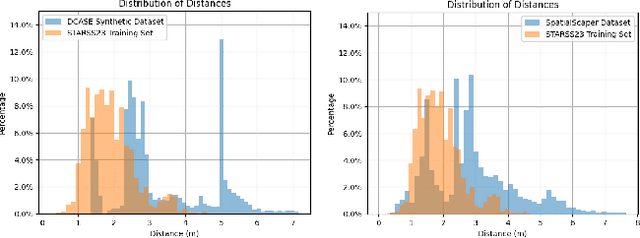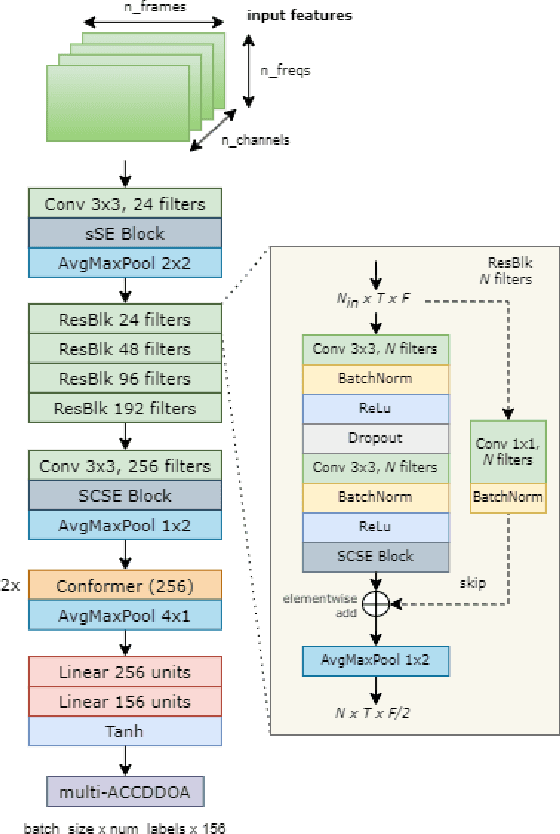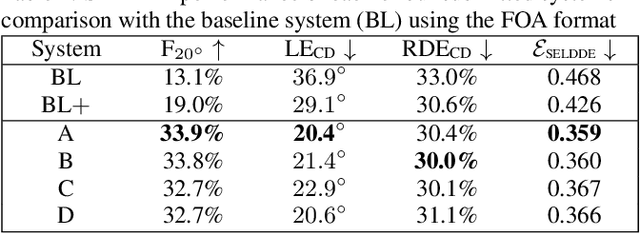Ee-Leng Tan
Data Efficient Acoustic Scene Classification using Teacher-Informed Confusing Class Instruction
Sep 18, 2024Abstract:In this technical report, we describe the SNTL-NTU team's submission for Task 1 Data-Efficient Low-Complexity Acoustic Scene Classification of the detection and classification of acoustic scenes and events (DCASE) 2024 challenge. Three systems are introduced to tackle training splits of different sizes. For small training splits, we explored reducing the complexity of the provided baseline model by reducing the number of base channels. We introduce data augmentation in the form of mixup to increase the diversity of training samples. For the larger training splits, we use FocusNet to provide confusing class information to an ensemble of multiple Patchout faSt Spectrogram Transformer (PaSST) models and baseline models trained on the original sampling rate of 44.1 kHz. We use Knowledge Distillation to distill the ensemble model to the baseline student model. Training the systems on the TAU Urban Acoustic Scene 2022 Mobile development dataset yielded the highest average testing accuracy of (62.21, 59.82, 56.81, 53.03, 47.97)% on split (100, 50, 25, 10, 5)% respectively over the three systems.
Real-Time Sound Event Localization and Detection: Deployment Challenges on Edge Devices
Sep 18, 2024Abstract:Sound event localization and detection (SELD) is critical for various real-world applications, including smart monitoring and Internet of Things (IoT) systems. Although deep neural networks (DNNs) represent the state-of-the-art approach for SELD, their significant computational complexity and model sizes present challenges for deployment on resource-constrained edge devices, especially under real-time conditions. Despite the growing need for real-time SELD, research in this area remains limited. In this paper, we investigate the unique challenges of deploying SELD systems for real-world, real-time applications by performing extensive experiments on a commercially available Raspberry Pi 3 edge device. Our findings reveal two critical, often overlooked considerations: the high computational cost of feature extraction and the performance degradation associated with low-latency, real-time inference. This paper provides valuable insights and considerations for future work toward developing more efficient and robust real-time SELD systems
Extracting Urban Sound Information for Residential Areas in Smart Cities Using an End-to-End IoT System
Aug 11, 2024Abstract:With rapid urbanization comes the increase of community, construction, and transportation noise in residential areas. The conventional approach of solely relying on sound pressure level (SPL) information to decide on the noise environment and to plan out noise control and mitigation strategies is inadequate. This paper presents an end-to-end IoT system that extracts real-time urban sound metadata using edge devices, providing information on the sound type, location and duration, rate of occurrence, loudness, and azimuth of a dominant noise in nine residential areas. The collected metadata on environmental sound is transmitted to and aggregated in a cloud-based platform to produce detailed descriptive analytics and visualization. Our approach to integrating different building blocks, namely, hardware, software, cloud technologies, and signal processing algorithms to form our real-time IoT system is outlined. We demonstrate how some of the sound metadata extracted by our system are used to provide insights into the noise in residential areas. A scalable workflow to collect and prepare audio recordings from nine residential areas to construct our urban sound dataset for training and evaluating a location-agnostic model is discussed. Some practical challenges of managing and maintaining a sensor network deployed at numerous locations are also addressed.
* 13 pages, 15 figures, journal
Squeeze-and-Excite ResNet-Conformers for Sound Event Localization, Detection, and Distance Estimation for DCASE 2024 Challenge
Jul 12, 2024



Abstract:This technical report details our systems submitted for Task 3 of the DCASE 2024 Challenge: Audio and Audiovisual Sound Event Localization and Detection (SELD) with Source Distance Estimation (SDE). We address only the audio-only SELD with SDE (SELDDE) task in this report. We propose to improve the existing ResNet-Conformer architectures with Squeeze-and-Excitation blocks in order to introduce additional forms of channel- and spatial-wise attention. In order to improve SELD performance, we also utilize the Spatial Cue-Augmented Log-Spectrogram (SALSA) features over the commonly used log-mel spectra features for polyphonic SELD. We complement the existing Sony-TAu Realistic Spatial Soundscapes 2023 (STARSS23) dataset with the audio channel swapping technique and synthesize additional data using the SpatialScaper generator. We also perform distance scaling in order to prevent large distance errors from contributing more towards the loss function. Finally, we evaluate our approach on the evaluation subset of the STARSS23 dataset.
Implementing Continuous HRTF Measurement in Near-Field
Mar 15, 2023



Abstract:Head-related transfer function (HRTF) is an essential component to create an immersive listening experience over headphones for virtual reality (VR) and augmented reality (AR) applications. Metaverse combines VR and AR to create immersive digital experiences, and users are very likely to interact with virtual objects in the near-field (NF). The HRTFs of such objects are highly individualized and dependent on directions and distances. Hence, a significant number of HRTF measurements at different distances in the NF would be needed. Using conventional static stop-and-go HRTF measurement methods to acquire these measurements would be time-consuming and tedious for human listeners. In this paper, we propose a continuous measurement system targeted for the NF, and efficiently capturing HRTFs in the horizontal plane within 45 secs. Comparative experiments are performed on head and torso similar (HATS) and human listeners to evaluate system consistency and robustness.
 Add to Chrome
Add to Chrome Add to Firefox
Add to Firefox Add to Edge
Add to Edge